Breez R2 Propane Tiller Cultivator: Product Review
We independently evaluate all recommended products and services. If you click on links we provide, we may receive compensation.
An outstanding, lightweight gasoline-alternative tiller cultivator.
Available on Amazon
Buy ItThe Ardisam Breez R2 Propane Tiller Cultivator (sold under Ardisam’s Earthquake brand) is the third cultivator I’ve reviewed in the last month. I’d never heard of Ardisam, a company with a 50+ year history, but their ‘About’ page resonated with me: “We invent, design and build tools for those who live, work and play outdoors.” Their company employs hunters, fishermen, and gardeners, so it’s not a surprise that they make products ranging from hunting stands to ice-fishing augers to garden cultivators.
With so many big-name companies like Troy-Bilt and Husqvarna making cultivators, why would Ardisam from Cumberland, WI, be worth a serious look?
Because their Breez R2 is incredibly lightweight, quiet, easy to maneuver, and the world’s first propane-powered cultivator on the market.
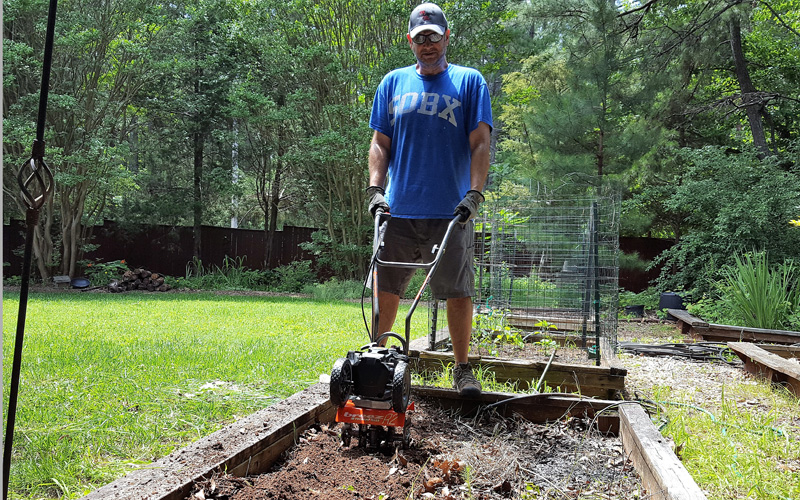
The Breez R2 is like a food processor for your garden
SPECIFICATIONS
| Weight | 32 lbs. |
| Engine | 40 cc, 4-cycle |
| Starting system | Standard recoil pull-cord |
| Fuel type | Propane (1 lb. cylinder) |
| Tines | 4-bladed, 8.66” tines (X4); forward-rotating; replaceable steel tines |
| Max tilling width | 10” |
| Max tilling depth | 8” |
| Transport | Wheels |
| Warranty | 1-year limited warranty on the tiller; 2-years limited warranty on engine |
FRAGILE DOESN’T MEAN WHAT IT USED TO
I’m to the point where I almost expect shipping boxes to arrive in rough shape. So in a way, the box holding the Breez R2 met my low expectations. True to many packages traveling over long distances, the cardboard box came with a few punctures and holes in it. But even with less than gentle handling, the tool arrived snuggled in molded cardboard that absorbed any shock it experienced. Inside, everything looked perfect.
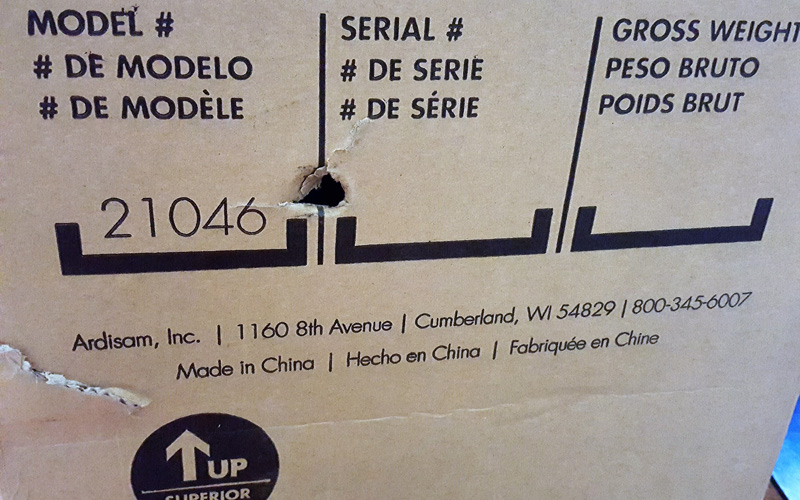
The box arrived looking rough, but the Breez R2 stayed snug and secure.
MOST PARTS ARRIVE PRE-ASSEMBLED
Even though I’m easily intimated when I see that assembly is required, a quick survey of the parts laid out in front of me revealed that I wouldn’t need an advanced engineering degree to put the pieces together.
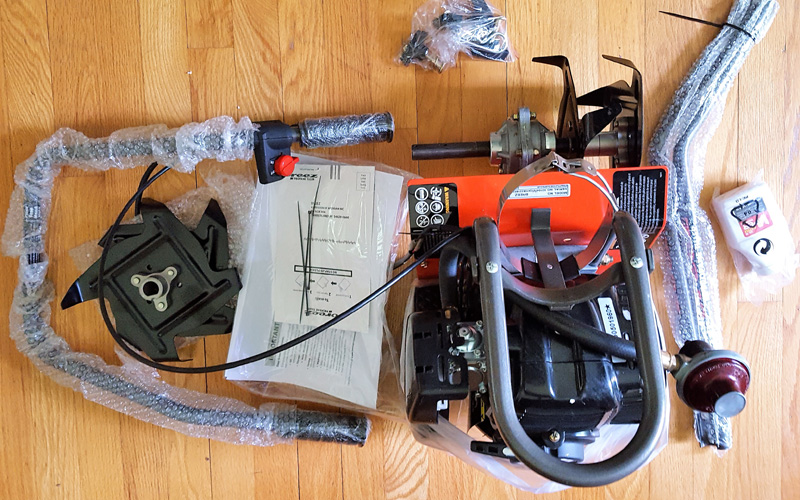
No worries! They pre-assembled the hard parts.
The Rest Is Easy To Assemble
The instructions were detailed, simple-to-follow, and intuitive.
To get the unit ready to roll, I slid two blades on the axel and secured them with a cotter pin (the other two blades came pre-attached). Then I put the handlebars in place and tightened them with plastic knobs.

Instructions can’t get much more simple and clear than these
Warning: Do not add the entire 4.06 oz. (included) bottle! The instructions call for 3.7 ounces. I would have preferred that they sent the exact amount required instead of forcing me to figure out how to measure AND pour exactly 110 mL out of a 120.0685 mL bottle.
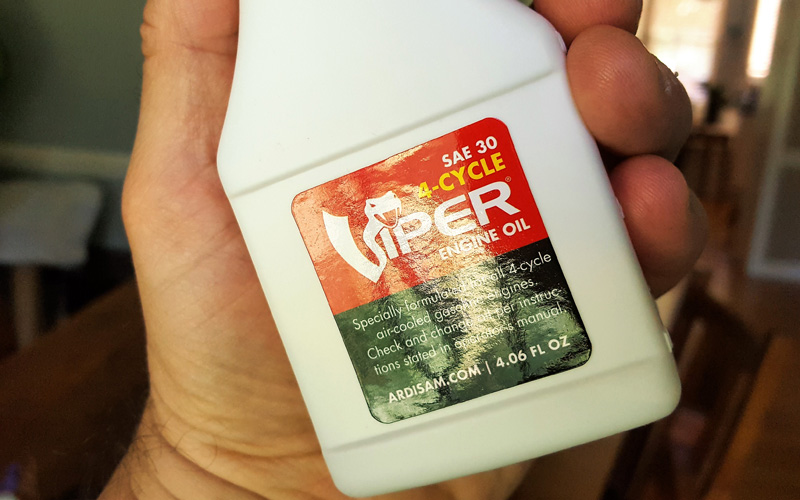
4.06 oz. of Viper 4-cycle oil comes included, but the unit requires only 3.7 oz.
Next, screw a 16 oz (not included) disposable propane fuel cylinder onto the regulator assembly.
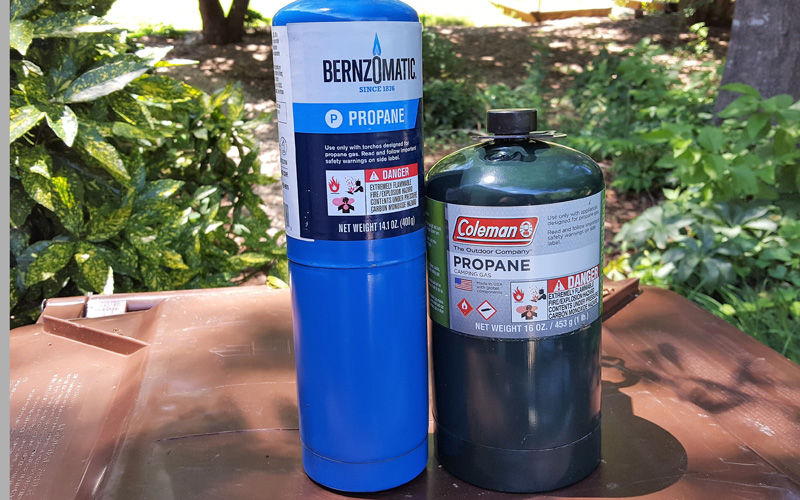
Don’t confuse the tall, thin 14 oz propane canister for the short, squat 16 oz canister required for the Breez R2.
When the male connector penetrates the seal on the propane canister, you might hear a slight psssst sound as propane fills the rubber tubing. This is normal.
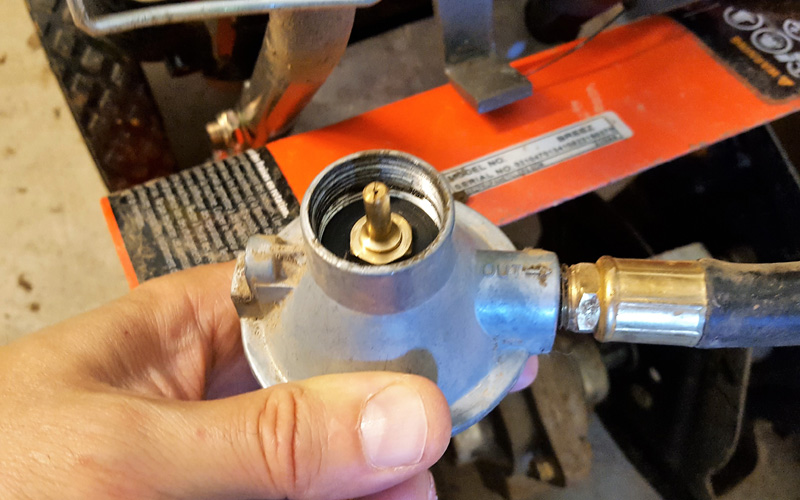
Rotate the propane canister (not the connector pictured) until you hear a small amount of gas escape to fill the rubber tubing
Finally, slide the cylinder into place at the back of the unit and snap the metal clip band around it to secure it to the frame.
You are now ready to roll!

Secure the propane cylinder by inserting into the holder and clipping the metal band until it’s snug
Easy To Start
I immediately liked the simplicity of the unit. To start it, move the ON/OFF switch to the ON position. There is no choke to mess with.
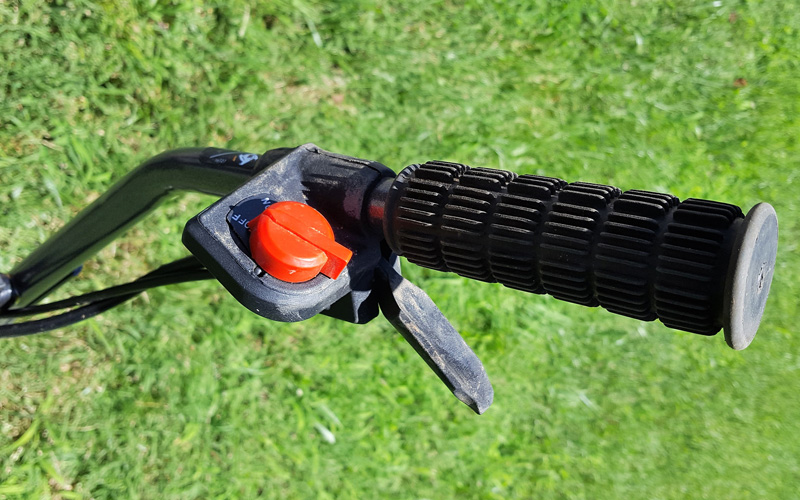
I love the simple ON/OFF switch and throttle on the right handle, along with the comfortable rubber handgrips
I haven’t measured, but I’m pretty sure that the muscles on the right side of my body are bigger than those on my left side because of all of the hard-to-start pull cords I’ve yanked on in my lifetime. But this one I liked. You don’t have to yank it. Just pull it, even gently. With two pulls, the engine engaged. That’s it. I believe that even people with limited hand or arm strength would have no problem pulling this cord back to start the engine.

I found the pull cord the easiest I’ve used, engaging the engine with just a couple of gentle pulls
I suggest that you start the engine where you plan to use it. Once it starts, you simply depress the throttle on the right handlebar to make the tines fire up.
FIRST IMPRESSIONS
When I was a kid, I couldn’t imagine a better career than cleaning windshields and pumping gas. In addition to having seriously low career aspirations, I just really loved the smell of gas, oil, and exhaust. Sadly, I developed an allergy to gasoline fumes even before full service gas stations disappeared. So the first thing I noticed after starting the Breez R2 was what was missing: a headache. No gasoline fumes!
That’s not to say you can start the Breez R2 in your house (not that I imagine you’d ever want to)! Just because the unit doesn’t emit gasoline fumes does NOT mean it doesn’t release carbon monoxide. Use the unit outside in a well-ventilated area as you would with any gas-powered tool.
Then I noticed how quiet the engine sounded at idle. No, it’s not a purring kitten. It’s still loud, but of the three units I’ve tested recently, this was the quietest. Still, I suggest earplugs since prolonged exposure to any loud noise can be hazardous to your hearing.
The final thing that popped out to me was the unusual position of the wheels while in the working position. Unlike most cultivators where the wheels follow behind the tines, the wheels on the Breez R2 sit atop the unit. This feature allows for the steadiest, easiest wheel transport of any unit I’ve tried. Leaning the cultivator forward on the wheels, it can be pulled where you plan to work using just one hand. They refer to this as Flip-and-Follow™ wheels, and I didn’t know I wanted this feature until I had it.
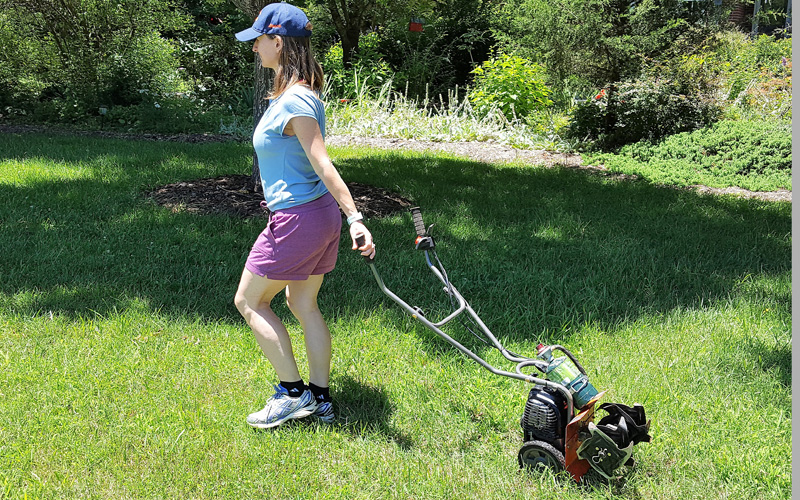
Many units I’ve tested have a difficult time being wheeled with two hands. The Breez R2 stayed steady with just one!
KICKING THE TIRES ON THE BREEZ R2
Cultivators should easily turn soil, mix in fertilizer, and weed between rows.
Test #1: Turning soil
According to Ardisam, the tines of the Breez R2 Propane Tiller Cultivator generate 250 RPMs. I will take them at their word. The four 4-tined blades went through soil easily, burying unwanted weeds and breaking up hard patches with ease.
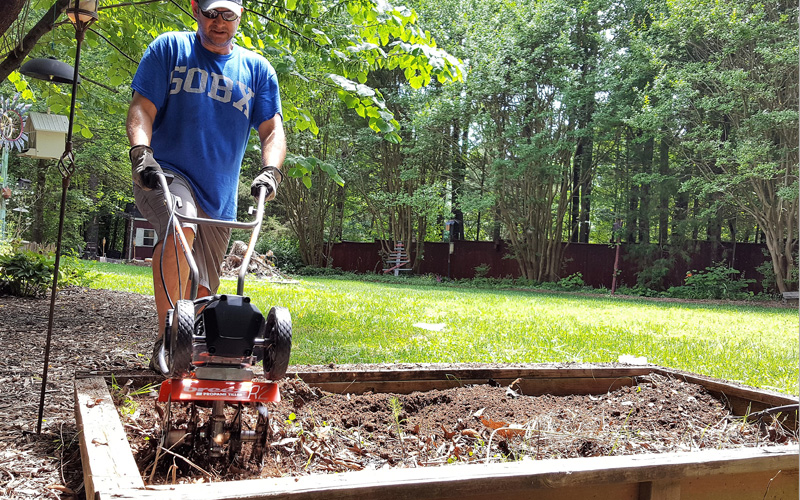
No roots were too deep to escape the Breez R2
Test #2: Mixing in compost
Once I turned the soil, I added bags of peat, mushroom compost, cow manure, and sand. Again, the cultivator blended the soils and compost materials with ease. In spite of not having wheels on the ground to help maneuvering, I had no problem guiding it where I wanted it to go.
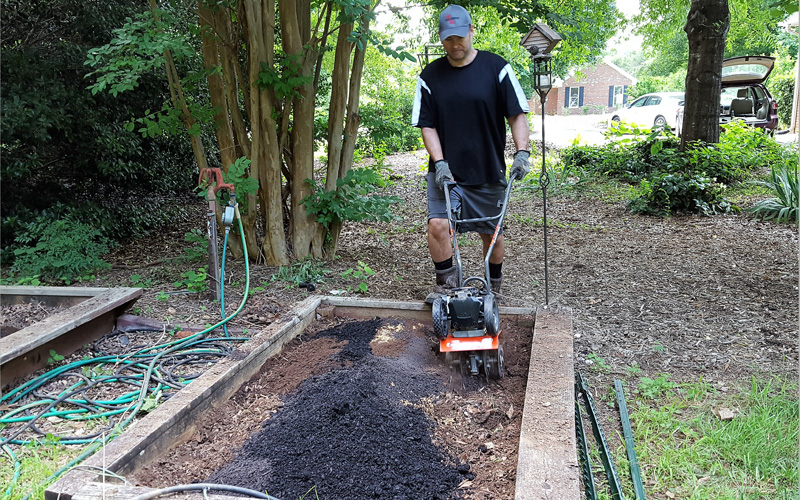
It took me more time to add sand, compost, and peat than to mix it in
Test #3 Bed weeding and “Off-road” weeding
Next, I turned the soil in a few beds that I’d ignored for a few years, beds crowded with Eastern Redbuds, pines, and knee-high weeds. The Breez R2 never hesitated when it tore into small saplings and tall weeds. That’s a powerful engine!
The next test was a little unfair: “off-road” weeding. I worked a patch of tall, invasive grass that’s started creeping into my lawn from the woods. In the winter, I burned as much of the grass as I could, and then I put a thick layer of mulch on top of it. Which did little to slow the progress of that evil grass. But since it started to return, I tested the cultivator over the mulched area across the weeds. The Breez R2 made quick work of the weeds. I ran the unit for about 20 minutes before the tines finally got choked with grass and slowed.
Fortunately, the designers chose to attach the tines with external-facing cotter pins. I quickly popped out the pins, slid off the blades, removed the debris, and reassembled the unit. Within 5 minutes, I was back to work.
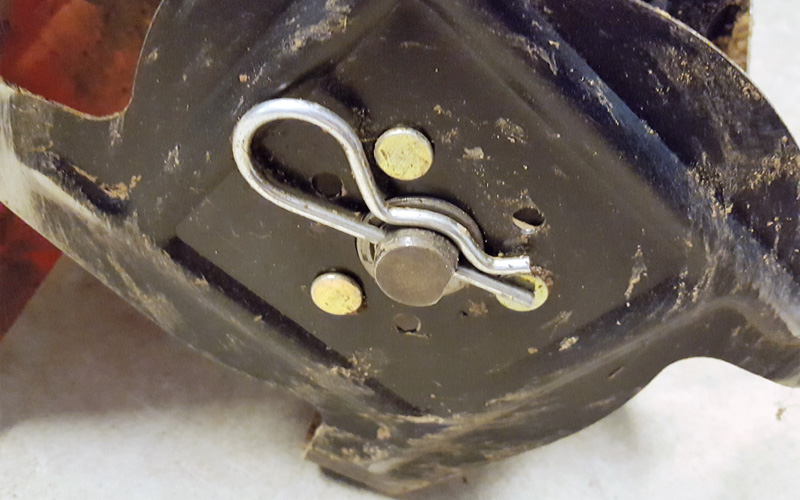
Large, externally mounted cotter pins made removal of the blades easy with a pair of needle nose pliers
Test #4: Digging Deeper
Breez R2 maker, Ardisam, has itself to blame for my final test. They named the unit the Breez R2 Propane TILLER Cultivator. A tiller is a more heavy-duty machine. The operator’s manual suggested that for harder soil, the blades could be reversed to give the unit a stronger bite. So that’s exactly what I did for the final test.
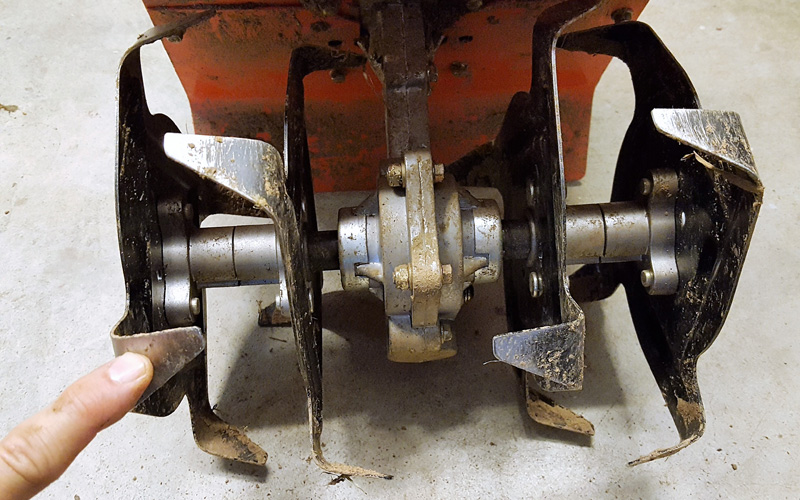
For the final test, I reversed the blades for more aggressive soil penetration
After marking a straight line on the ground where I plan to build a French drain, I made several passes with the Breez R2. To be fair, this unit is NOT intended as a substitute for a tiller, a DitchWitch, or a back hoe. Just the same, it did a really great job of softening and displacing the soil in my trench, kicking up the occasional rock and exposing roots along the way. I used an axe to severe the roots and a shovel to remove loosened soil.
I trenched down about a foot before stopping. It wasn’t always pretty, and a few times it bucked like a strong, angry mule. But the unit endured in great shape, and it saved me an hour or more of serious digging. Impressive!
WARRANTY
The Ardisam Breez R2 Propane Tiller Cultivator comes with a 1-year warranty covering the entire tiller and 2 years on the engine.
BOTTOM-LINE…
Here’s what I liked most about the Breez R2 Propane Tiller Cultivator:
- The engine had plenty of power for everything I asked it to do;
- Easy to start, stop, maneuver, and operate;
- Top-mounted wheels (Flip-and-Follow™ wheels) that made one-handed transport a snap;
- The external cotter pins attaching the blades to the axle made for easy tine clean-out;
- The blades are replaceable should the need arise;
- Runs 60-90 minutes on one propane canister;
- No gasoline means none of the typical problems with gas fumes, gas spills, stale gas, or engine gumming;
- Quieter than typical engine noise;
- Its sturdy construction keeps vibration low, and its lightweight design makes it easier to use for longer sessions.
If I had any suggestions for improvement for the Breez R2, it would be three things:
- Add an electric start option. While I found the pull-cord start the easiest I’ve used, those with limited hand or arm strength might be scared off purchasing this (however, I’m aware that most people with limited hand or arm strength probably shouldn’t be using a cultivator in the first place!);
- Add a depth bar. Since the unit doesn’t have a depth bar (which is usually on the same post as the wheels), the unit can dig too deep in one spot; and
- Create a tool to refill 1 lb. propane cylinders safely. No good deed goes unpunished. The Breez R2 is a fantastic tool, and the first of its kind using propane! And while I love the convenience, price, and stability of propane over gasoline, it kills me to fill a landfill with disposable propane cylinders. I’ve seen kits that allow you to refill 1 lb. tanks using a bigger tank, but most reviews suggest that this is NOT a safe practice. So when you have time, can you figure out a way to turn disposable into reusable?
Hypothetically, let’s say my wife were to say to me, “You have so many tillers in the garage, we can’t even fit one car inside. Can you just keep one, and get rid of the rest?” Hypothetically, I would tell her, “I’m keeping the Breez R2.” Because I am.
Where To Buy 
You can order the Breez R2 directly from Earthquake for $299. Or you can find it on Amazon Prime for $254.85.
Now over to you – Would you try a propane-powered tiller? Let us know in the comments below!
Enjoyed This Review?
If you liked this review, please sign up for our email updates with reviews, how-to articles and gardening videos!

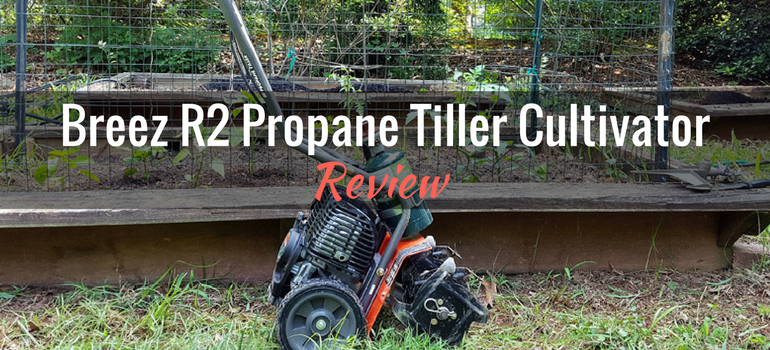



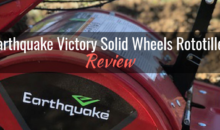


Great review. I also have this tiller and it works great. I especially like that it is propane propelled. My only negative comment is the strap that holds the propane bottle in place. I had to reinforce it with a bungee cord. Other than that, it is light and powerful as you noted and does a good job.
I bought one of these tillers in February. A few days ago I assembled it and attached a propane cylinder. The steel strap / toggle type buckle for securing the tank would not latch even though the correct 3.875″ diameter tank was used. Secondly, when I did attach a propane tank to the regulator I could hear and smell a continuous flow of gas coming out of the carburetor.
Has anyone else experienced the problems I mentioned above? Initially, the manufacturer said that I should remove the fuel cylinder when the tiller was not in use. What if I got distracted by something like a phone call, a rock that I needed to move, the UPS truck coming up the driveway, etc? Escaping gas is a safety problem.
So the manufacturer agreed to send a new fuel tank strap and a regulator / hose assembly with a manual shut-off valve.
Again, has anyone else experienced the problems I described? I still have a problem understanding how a manufacturer would expect an operator of this tiller to remember to unscrew the fuel tank after each use.